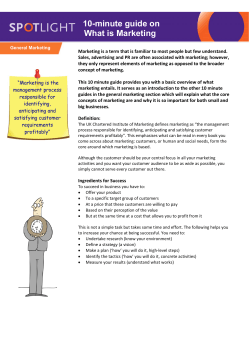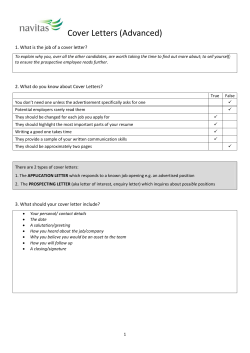
Document 375928
Asia Pacific Journal of Research Vol: I Issue XVIII, October 2014 ISSN: 2320-5504, E-ISSN-2347-4793 A STUDY ON IMPACT OF ADVERTISEMENT ON BUYING BEHAVIOUR OF CONSUMERS (WITH SPECIAL REFERENCE TO TWO WHEELER CUSTOMERS IN CHENNAI CITY) Dr.M.Rajesh, Research Supervisor & Guide D.B.Jain Colleg, Chennai-97. A.Senthil Kumar, Research Scholar ABSTRACT Advertising is a stimulating influence in our modern civilization, which affects our standard of living, our forms of recreating and our selection of goods. “Advertising, the use of visual or auditory messages by a person or firm to persuade other buy a product, accepts an idea or takes some other desired action where there is no direct contact between the advertiser and audience.” Advertising has become an integral part of our society. In a way, it has become embedded in our daily lives. People cannot go through a newspaper, listen to radio or watch television, without reading, hearing or seeing some advertisement or commercial. People see them on billboards, on buses, in trains, in magazines, on match boxes, some messages aimed at influencing us or making us aware of the advertiser’s product. INTRODUCTION Advertising consists of all the activities involved in presenting to a group of non-personal, oral or visual, openly sponsored message regarding a product, service or idea. This message, called an advertisement, is disseminated through one or more media and is paid for by the identified sponsor. Advertising performs its role within the framework of marketing. Marketing is the function concerned with ensuring that product are ready when and where needed by consumers. Understanding of advertisement and its role in modern society is one characteristic of being an informal person in today’s world. CRITICISM OF ADVERTISING: While advertising can be seen as necessary for economic growth, it is not without social costs. Unsolicited Commercial Email and other forms of spam have become so prevalent as to have become a major nuisance to users of these services, as well as being a financial burden on internet service providers. Advertising is increasingly invading public spaces, such as schools, which some critics argue is a form of child exploitation. In addition, advertising frequently uses psychological pressure (for example, appealing to feelings of inadequacy) on the intended consumer, which may be harmful. 10 Asia Pacific Journal of Research Vol: I Issue XVIII, October 2014 ISSN: 2320-5504, E-ISSN-2347-4793 NEED FOR THE STUDY: The liberalized economy in India leads both male and female to go to job and thus, their commutations become very important. So, they opt the assistance of two wheelers instead of public transport for the pleasant commutations. The two wheeler becomes inevitable, and also the cost is reasonable, therefore they are meticulous in choosing the best two wheelers. They hence require more information about two wheelers however they are guided and influenced by the advertisements. Therefore the advertisements influences their preferences, purchase decision and post purchase behaviour. So, the present study concentrates on the impact of advertisements on the consumer buying behaviour towards two wheelers. In particular the city of Chennai has been chosen for the purpose of study because of the following reasons: Chennai city has become the financial hub of the entire country. Most of the I.T. industries, automobile industries recently established in Chennai. It is the most highly density populated area. Because of petrol consumption, high price of the cars and traffic congestion, most of the Chennai ties prefer to travel in two wheelers. So the people in Chennai they want to own the two wheelers. OBJECTIVES OF THE STUDY To establish the relationship between advertisement and post purchase behaviour of the twowheeler customers. To analyze the relationship between demographic variables and advertisement factors influencing buying motives, product recognition and buying decision of two wheelers customers. To construct an empirical model to establish the impact of advertisement on buying behaviour of two wheeler consumers. RESEARCH METHODOLOGY The Chennai metro city two wheeler customers are selected as a suitable setting to test the proposed research model. Mainly the focus is on impact and evaluation of two wheeler advertisement on buying behaviours of customers towards two wheelers. The main reason for selecting this topic are (i) availability of a higher number of two wheeler customers (ii) Availability of a number of customers – dealers contacts in the two wheeler industry. The methodology of the study is based on the primary as well as secondary data. The study depends mainly on the primary data collected through a well-framed and structured questionnaire to elicit the well-considered opinions of the respondents. Convenient random sampling is adopted to obtain the responses from the two wheeler consumers of Chennai metro city. This study employs both analytical and descriptive type of methodology. The secondary data are collected from journals, magazines, publications, reports, books, dailies, periodicals, articles, research papers, websites, company publications, manuals and booklets. REVIEW OF LITERATURE Backhaus, Muhlfeld, and Doorn, (2001) Others researchers have been more interested in what was actually standardized or adapted in an advertisement (Harris, 1994) (e.g. creative selling proposition, elements in the advertisement and the language) or whether the advertisement uses the same theme, regardless of changes in copy or illustration (Duncan and Ramaprasad, 1995; Onkvisit and Shaw, 1987; Sriram and Gopalakrishna, 1991). Others argue that an advertisement is standardized when the consumers say so. 11 Asia Pacific Journal of Research Vol: I Issue XVIII, October 2014 ISSN: 2320-5504, E-ISSN-2347-4793 Luna and Peracchio, (2001) it is rare for a print advertisement to not have a picture, as pictures have been shown to improve memory (Schmitt et al., 1993; Shepard, 1967; Starch, 1966). This is consistent with (Paivio, 1971) dual-coding memory theory, which states that recall is enhanced if information is encoded in two systems (verbal and imagery) rather than one (usually verbal). Pictures are used to illustrate the brand and product in order to obtain better recall (McKelvie and MacGregor, 1996). However in the case of bilingual consumers, the visual image must be consistent with the wording to help in the comprehension of the second language. O'Guinn, Allen, and Semenik, (2003) found that Advertising has been defined as a paid, massmediated attempt to persuade Thus the Advertising is the powerful instrument to choose the peoples' choice. Advertisements also have power like: the power to choose, the power to think for themselves, and the power to influence others. How they use that power is central to the creation of good and healthy society. ANALYSIS Gender Gender Male Female Total Source: Primary Data Frequency 55 45 100 Valid Percent 55.0 45.0 100.0 From the above table, it is found that 55.0% of the respondents are male and 45.0% of the respondents are female. Age Age group Less than 25 yrs. 26-35 yrs. 36-45 yrs. Above 45 yrs. Total Source: Primary Data Frequency 20 43 15 22 100 Valid Percent 20.0 43.0 15.0 22.0 100.0 From the above table it is inferred that 20.0 % of the customers are in the age group of less than 25 years. The customers above 45 years of the age group are covered only 22.0 % of the total sample. Therefore it is inferred that maximum number of customers belongs to the age group of 26-35 years. Education Education SSLC HSC Graduate Post graduate Diploma holders Total Source: Primary Data Frequency 20 18 15 12 35 100 Valid Percent 20.0 18.0 15.0 12.0 35.0 100.0 12 Asia Pacific Journal of Research Vol: I Issue XVIII, October 2014 ISSN: 2320-5504, E-ISSN-2347-4793 From the above table it is noted that 20.0 % are SSLC qualified, 18.0% are HSC qualified, 15.0% are graduates, 12.0% are qualified post graduates and 35.0% are the diploma holders. Hence, it is analyzed that maximum number of two wheeler customers are the diploma holders. Occupation Occupation Professional Government employee Private service Business Students Total Source: Primary Data Frequency 12 23 19 25 21 100 Valid Percent 12.0 23.0 19.0 25.0 21.0 100.0 From the above table it clearly shows that 12.0 % of the respondents are professionals and 19.0 % of them are employed in private service and 23.0% of the respondents are government employees. So, it has been noted that vast majority of the above respondents are Business. Earning members in the family Family Members Employed 1 member 2 members 3 members Total Source: Primary Data Frequency Valid Percent 35.0 45.0 20.0 100.0 35.0 45.0 20.0 100.0 From the above table it is inferred 35.0 % are single member, 45.0% showing that two members, 20.0% are three members earning in the family. It is confirmed from the above analysis that families having two earning members are the maximum percentage when compare with other variables. Family Monthly Income Monthly Family Income Up to Rs.10,000 Rs.10,0001to Rs.20,000 Rs.20,0001to Rs.30,000 More than Rs.30,000 Total Source: Primary Data Frequency 34 23 24 19 100 Valid Percent 34.0 23.0 24.0 19.0 100.0 From the above table it is found that 34.0% of the respondents having a monthly income less than Rs.10, 000. There are only 19.0 % of the two wheeler customers have a monthly income more than Rs.30, 000. From the above analysis it clearly states that the maximum of two wheeler customers are having a monthly income Up to Rs.10, 0001. SUGESSIONS The performance of the two wheelers and quality assurance can be more emphasised through better marketing strategies by the companies apart from celebrity endorsements. 13 Asia Pacific Journal of Research Vol: I Issue XVIII, October 2014 ISSN: 2320-5504, E-ISSN-2347-4793 Emphasis can be laid on endorsing the two wheelers’ features, quality, brand and model through celebrity endorsed advertisements in television which should also be supported by information pertaining to providing financial assistance. This can be done through alliances with banks and other financial institutions and also bringing it to the notice of the consumers. While considering the stiff competition, the manufacturers should identify their market segment and adopt strategies that would improve their market share. CONCLUSION The buying decisions and information search are also influenced by the two wheeler advertisement. The personal factors age, education, occupation, gender and income influence the factors of advertisement pertaining to buying motives, buying decision and post purchase behaviour. The customers are meticulous in verifying the product characteristics displayed in the advertisement after their purchase. It is concluded that incredible advertisements creates negative effects on the advertisement and it is useful to recall the brand of the product but is not useful to materialize their purchase of two wheelers. REFERENCES 1. Backhaus, Muhlfeld, and Doorn, (2001) Journal of Marketing, 58(1), 21-23. 2. Luna and Peracchio, (2001) Indian Journal of Marketing, Vol. XXV (9), July 2001. 3. O'Guinn, Allen, and Semenik, (2003). Journal of Marketing, 61(1), 60-62. 26-31, 14
© Copyright 2025












